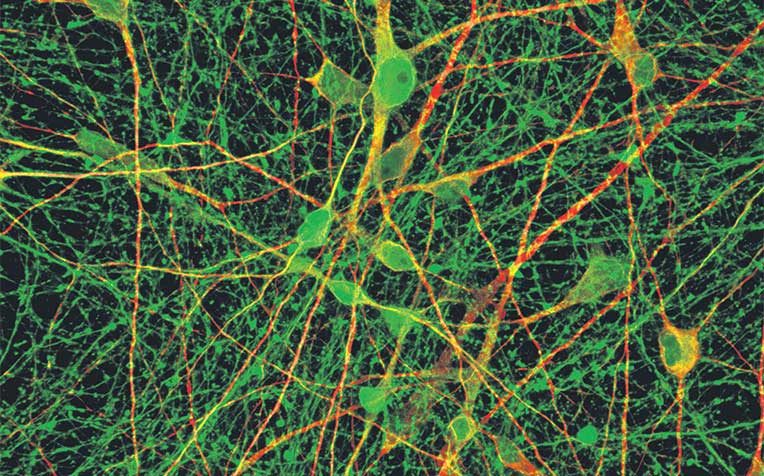
showing up green and red under the microscope with the help of immunostaining – a dyeing process which helps researchers from Duke-NUS Medical School, National Neuroscience Institute and A*Star’s Genome Institute of Singapore identify the nerve cells.
About 100 billion neurons in the human body keep us thinking, feeling and moving throughout the day.
These nerve cells fire electrical signals and transmit information – what we see or hear, for instance – through synapses, the connections between them.
For years, scientists have been struggling to produce neurons in the lab speedily.
Having a ready supply of neurons would enable them to screen for drug targets and better understand what goes wrong in the nerve cells of patients with schizophrenia and autism, as well as other psychiatric and neurological disorders.
In a breakthrough, scientists in Singapore have found a way to make nerve cells two to three times faster than conventional methods.
These lab-produced cells are almost identical to the real thing.
“In the case of neurological disorders such as Alzheimer’s, people found drugs which worked on mice but never actually worked for humans,” said Dr Shawn Je, an assistant professor in the Neuroscience and Behavioural Disorders Programme at Duke-NUS Medical School. “What if we can actually make human neurons? That’s how the project started.”
Current methods used by scientists to produce human neurons take 10 to 30 weeks and bring low yields. They are made using human pluripotent (capable of turning into any type of cell) stem cells generated from blood and skin cells. These cells are then differentiated to become neurons.
The yield, however, leaves much to be desired because not all of them can be reprogrammed into functional nerve cells.
“You start off with millions of stem cells, but you may end up with neurons in the thousands or fewer,” said Dr Je.
“Many of the cells actually die off along the way, and the surviving ones are of different kinds and are typically immature. This is not ideal for modelling.”
What Dr Je’s team has done is to produce neurons from stem cells by turning on specific genes that instruct stem cells to differentiate into neurons.
It takes them six to eight weeks to produce functional neurons – about two to three times faster than conventional methods. Tests show the lab-created neurons are more than 90 per cent similar to the real thing, and are electrically active like neurons in the human brain.
There are plans to commercialise the process eventually, but the team is looking at making the process more effective first, and making other types of neurons.
This method also helps to lower costs and ensures that the neurons are produced homogeneously.
“The neurons also need nutrients, which are costly, so if it takes around half a year to produce them, you can imagine the cost of having to feed them with nutrients for that period of time,” said Dr Alfred Sun, research fellow at National Neuroscience Institute and A*Star’s Genome Institute of Singapore.
No one really knows what causes schizophrenia and autism, said Dr Je, but there is a type of neuron that could hold the answer. GABAergic neurons (GNs) make up 10-15 per cent of the human brain, and work together with excitatory neurons to ensure balanced brain activity.
In mice, it has been observed that excessive activities from excitatory neurons lead to epilepsy.
“In schizophrenia or autism, patients look normal from the outside,” said Dr Je.
“But we believe there’s a certain type of change in their nerve cells – although not dramatic. These nerve cells (GNs) do very important monitoring roles.”
Dr Je’s team is studying the mechanism of GNs in patients with autism and schizophrenia so that they can screen for potential drug targets to treat the disorders.
Contributed by














 Get it on Google Play
Get it on Google Play